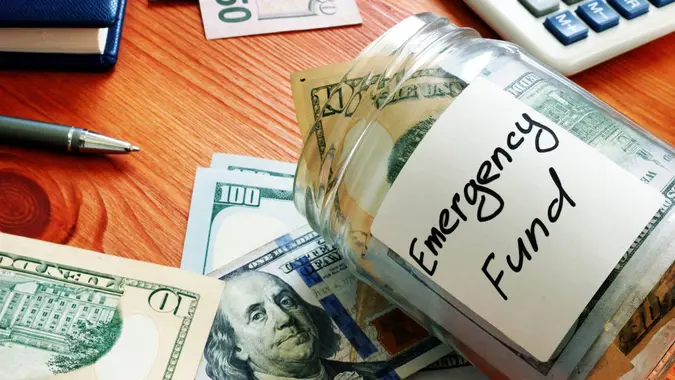5 Key Signs You’re Experiencing Lifestyle Creep & How To Stop It

Commitment to Our Readers
GOBankingRates' editorial team is committed to bringing you unbiased reviews and information. We use data-driven methodologies to evaluate financial products and services - our reviews and ratings are not influenced by advertisers. You can read more about our editorial guidelines and our products and services review methodology.

20 Years
Helping You Live Richer

Reviewed
by Experts

Trusted by
Millions of Readers
Your budget is a constant battle between how you spend money and your general saving habits — and lifestyle creep doesn’t help.
Lifestyle creep occurs when you increase your expenses as your income goes up, often on unnecessary items. While it’s normal to want to improve your lifestyle as you make more money, this can interfere with your long-term financial goals.
If you are looking to upgrade your situation without lifestyle inflation, you need to assess your standard of living through all the economic phases of your life. As your income increases along with your spending habits, it’s easy to fall into the trap of lifestyle creep without even realizing your savings account isn’t keeping up. Here are some subtle indicators that you are hemorrhaging cash as opposed to practicing mindful spending — and how you can avoid this common pitfall.
You’re Constantly Upgrading or Making Impulse Purchases
The urge to upgrade your car, house or gadgets with every salary increase is natural and well-earned in some cases. However, just because your credit card has a higher spending limit doesn’t mean you should max it out.
To avoid lifestyle creep like this, consciously allocate a significant portion of any extra income to savings or investment accounts. This strategy ensures that you’re building wealth, not just enhancing your lifestyle.
Impulse buying, especially for items you don’t need, is a subtle sign of lifestyle creep. Implement a rule where you wait for a set period of time before making non-essential purchases. If the desire passes, you save money.
You’re Prioritizing Splurging Over Saving
If you find yourself spending first and saving what’s left, flip this habit. Adopt a “pay yourself first” approach by prioritizing savings and investments as soon as you get paid. Having a little extra cash, whether it’s from a raise or passive income, is a great time to put aside some funds in an emergency savings account or really start some heavy lifting with your retirement plan.
Food costs are at an all-time high and eating out constantly can be detrimental to your budget. This doesn’t mean you can’t go out and splurge on a nice meal once in awhile to celebrate or treat yourself, but if you find yourself eating at expensive restaurants more often, it’s time to reassess.
Set a budget for dining out and try to cook at home more. Not only does this save money, but it can also be a healthier option. Try buying generic brands at the grocery store too instead of always going with the name brand. Remember, a higher price doesn’t always mean better value.
You’re Neglecting Budgeting and Financial Goals
Not keeping track of your expenses can lead to uncontrolled spending. Regardless of your income, maintain and track your budget to see where money is moving out of your account and where there is wiggle room. Regular expense tracking is essential to manage finances effectively.
Without clear financial goals, you’re more likely to spend aimlessly. Set specific short-term and long-term financial objectives to give direction to your savings efforts.
You’re Overlooking Small Expenses
Small expenses can accumulate into significant amounts. Be mindful of every expenditure, no matter how small, and recognize their impact on your overall financial health.
Check if you have subscriptions you rarely or never use. Streamline your subscriptions by canceling those that aren’t essential, freeing up more funds for savings. Sometimes when things are on autopay it’s easy to forget how you are actually spending your money.
You’re Giving In to Peer Pressure Spending
One of the biggest signs and culprits of lifestyle creep is the urge to keep up with the Joneses. Spending more to match friends or colleagues is a common trap.
Stay true to your financial limits and suggest more cost-effective activities when socializing if that helps.
How to Stop Lifestyle Creep
If you’re earning more but not saving more, it’s time to take control. Here’s how to stop lifestyle creep before it chips away at your financial goals:
- Set meaningful financial goals. Write down both short- and long-term goals and keep them visible. This keeps your spending aligned with what truly matters.
- Automate your savings. Set up automatic transfers to savings or retirement accounts each time you get paid–especially after a raise. A good rule of thumb: save at least half of any income increase.
- Live below your means–on purpose. Just because you earn more doesn’t mean you should spend more. Stick to a spending plan like the 50/30/20 rule: 50% needs, 30% wants, 20% savings.
- Regularly review your budget. Check your finances monthly or quarterly to spot creeping costs like forgotten subscriptions or inflated lifestyle expenses.
- Be mindful of emotional spending. Don’t let social pressure or “I deserve this” thinking guide your purchases. Spend intentionally on what brings real joy and skip the upgrades that don’t.
- Think in time, not just dollars. Before you buy something, consider how many hours of work it took to earn that money. It helps separate meaningful purchases from impulse buys.
Recognizing and addressing lifestyle creep is crucial for maintaining financial health and achieving long-term goals. By being mindful of these sneaky signs, you can enjoy a comfortable lifestyle without compromising your financial future. Remember, the key is to find a balance between enjoying the present and preparing for the future.
 Written by
Written by  Edited by
Edited by 
























